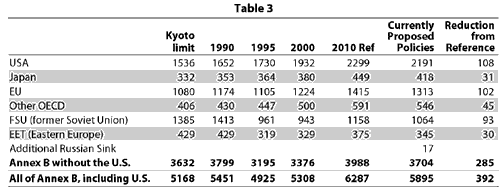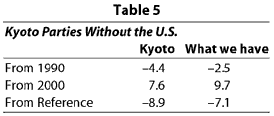
 Massachusetts Institute of Technology
Massachusetts Institute of Technology
March 2002 [PDF: 135 kB]
This note shows the implications of the United States Administration's proposed reduction plan (announced in February 2002) based on the MIT EPPA model reference projections, and compares the results to our estimates of the reductions that would occur in the rest of Annex B if they ratify the Kyoto Protocol as it was negotiated at Marrakech.
Table 1 shows the MIT reference estimates/projections for GDP, and total greenhouse gases (GHGs) for 2000 to 2010 stated in terms of millions of tons of carbon equivalent (mtce). I have calculated the GHG intensity and its change over time, and the results are somewhat different than those of the Administration, which reports 0.183. The reason for the difference is not clear, but they are likely using year 2000 dollars instead of 1995 dollars and slightly different emissions estimates for "today." The absolute level is less critical than the percentage reduction in any case. We project that under reference conditions emissions intensity decreases by 1.5% per year, for a total decrease of 14%.

The Administration identified its goal of decreasing emissions intensity by 18% from 2002 to 2012. EPPA solves only every 5 years, so I use the 2000 to 2010 estimates from EPPA to approximate the 2002 to 2012 period. In Table 2, I calculate that the 18 percent reduction in emissions intensity from 2000 would require an intensity of 0.188 in 2010. This is an annual reduction of almost 2% per year compared with our reference reduction of 1.5% per year. By multiplying this intensity times our GDP estimate from Table 1, I calculate the emission cap in 2010 to be 2191 mtce. Emissions will thus be increasing at 1.26% per year instead of 1.74% per year.

Table 3 shows our calculations for the Kyoto limit applied to each of our regions. This is simply the 1990 emissions times the percentage reduction spelled out in the Kyoto Protocol. I also provide the 1990 and 1995 estimates of total GHG emissions from our EPPA model. There are some differences in our estimates from various official sources because of some slight accounting differences both in energy and in other GHGs. I also include our 2000 estimate and our 2010 reference projection without any policy. In the column labeled "Currently Proposed Policies," I show the 2191 emissions cap for the U.S. as calculated above and our estimates of emissions from each of the other Annex B countries if they implement Kyoto with a cap and trade system and take full advantage of the flexibility mechanisms, across gases and across countries. This assumes all the Russian "hot air" is credited against emissions in 2010--i.e., none is banked and the Russians do not restrict supply in any way to increase the permit price. These estimates are from a pre-Marrakech scenario. I thus identify, as a separate line, the additional Russian sinks of 17 mtce allowed at Marrakech. In fact this 17 mtce would allow all of the Kyoto implementing countries to increase their emissions slightly so that the total emissions for the group is higher by 17 mtce but the effects of this additional amount on any region would be small (<< 17 mtce).

One thing to observe from Table 3 is that by our calculation the U.S. would reduce in 2010 from reference by 108 mtce--very close to the 100 mtce the Administration identified. The slight difference may reflect a more up-to-date estimate of 2002 or 2000. Our EPPA model has not yet been calibrated to match 2000 exactly, as that data has just become available. One can also note that the U.S. reduction of 108 would be more than any other region and is close to the 102 mtce we estimate the E.U. would need to reduce under the policy conditions we simulated. In fact, the E.U. could emit somewhat more given the additional 17 mtce of Russian sink that we have not allocated to any region and thus they could reduce by less than 100 mtce and the group could still meet the Marrakech target. The U.S. would account for slightly over 25% of the total reduction, a significant share, but the U.S., by our estimate, would have accounted for about 37% of emissions in 2010 in the reference. So looked at that way, one might conclude that its fair share of the total reduction should be 37%, thus making the 25% appear somewhat inadequate. Regions of the former Soviet Union (FSU) and Eastern Europe (EET) both show real reductions in these scenarios--they sell all their hot air, plus they reduce further to sell permits. We (Babiker et al., 2002) report a very low price of carbon under these conditions. Also, we find that most of the reductions (upwards of 90%) could come from other GHG reductions--so for example Russia's real reductions (here approximated by the FSU) are from reducing methane emissions and the like.
"How does this compare with Kyoto?" is a question many have asked. Table 4 makes this comparison for the Annex B as a whole. A "pure" Kyoto without any sinks would have reduced emissions by 5.2% from 1990 by our and most estimates (although the new data from Energy Information Agency that breaks out the FSU results in a slightly different estimate--5%, I believe). Because of the hot air, and all Annex B emissions in 2000, by our estimate, were below 1990, the reduction is only 2.6% from 2000. We project substantial growth from 2000 to 2010--we are not expecting another Russian and Eastern Europe collapse and in fact we expect them to recover and grow somewhat. As a result, Kyoto, without any sinks, would have resulted in a nearly 18% reduction below 2010.
In fact, Kyoto without the U.S. achieves much less (there are sinks, plus the U.S. does not take any of the hot air so that allows higher emissions for the remaining Kyoto Parties) and the new independent U.S. goal is quite a bit less ambitious. The combination of these policies means that "what we have" in terms of climate policies achieves much less than what Kyoto would have achieved with the U.S. and without the sinks. Instead of a 5.2% reduction from 1990, we estimate that emissions in Annex B as a group will be 8.1% above 1990. Instead of a nearly 18% reduction from our reference emissions, the aggregate reduction will be 6.2%.

Another comparison that was made by the U.S. Administration material was the reduction in the U.S. compared with the Kyoto Parties reduction. The 108 mtce reduction we estimate for the U.S. is a 4.7% reduction from reference--very close to the Administration's reported reduction of 4.5%. Again, they may be using a slightly different base as the GHG intensity or other slight differences, so for practical purposes these are the same. Table 5 shows that the Kyoto Parties reduction will be, by our estimate 7.1% below reference and this compares with the 7.2% reported by the Administration as our estimate. The slight difference is probably rounding error. I also show the change for the Kyoto Parties from 1990 and 2000. I compare these with the pure Kyoto reductions identified in the agreement for these parties only--so this is without the U.S. as well. Thus, the difference between the original Kyoto and "What we have" now in Table 5 is attributable to the additional sinks that were agreed to in Bonn and Marrakech. As can be seen, the Marrakech agreement will allow this group to increase emissions from 2000 by almost 10%. But, even the original Kyoto reductions for this group (i.e. without the sinks) would have allowed an increase for this group from 2000 of 7.6%. Thus, the absence of the U.S.--without its demand for hot air--means considerably less of real reduction among the remaining Kyoto Parties.

